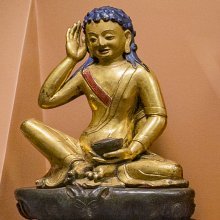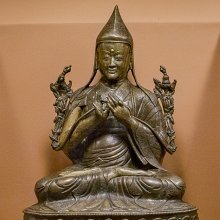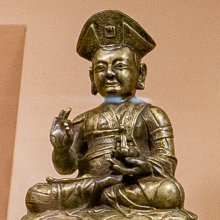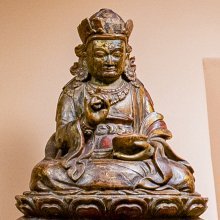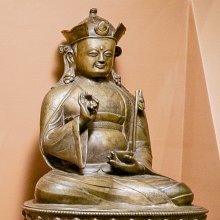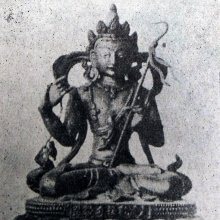Mahasiddha, Mahāsiddha, Maha-siddha: 8 definitions
Introduction:
Mahasiddha means something in Buddhism, Pali, Hinduism, Sanskrit. If you want to know the exact meaning, history, etymology or English translation of this term then check out the descriptions on this page. Add your comment or reference to a book if you want to contribute to this summary article.
Images (photo gallery)
(+1 more images available)
In Hinduism
Purana and Itihasa (epic history)
Source: archive.org: Shiva Purana - English TranslationMahāsiddha (महासिद्ध) refers to “great Siddhas” (viz., engrossed in devotion), according to the Śivapurāṇa 2.2.40.—Accordingly, as Brahmā narrated to Nārada:—“[...] after going beyond Alakā, the capital of the king of Yakṣas and the Saugandhika park, they saw the fig-tree of Śiva. [...] Beneath that vaṭa of yogic potentialities, Viṣṇu and other Devas saw Śiva seated. The vaṭa was the refuge of those seeking salvation. Śiva was being served and venerated by Brahmā’s sons, the great Siddhas (i.e., mahāsiddha) engrossed in devotion to Śiva joyously. They were calm. Their very physical body inspired calmness”.

The Purana (पुराण, purāṇas) refers to Sanskrit literature preserving ancient India’s vast cultural history, including historical legends, religious ceremonies, various arts and sciences. The eighteen mahapuranas total over 400,000 shlokas (metrical couplets) and date to at least several centuries BCE.
Shaktism (Shakta philosophy)
Source: Google Books: ManthanabhairavatantramMahāsiddha (महासिद्ध) refers to a “great Siddha”, according to the second recension of the Yogakhaṇḍa of the Manthānabhairavatantra, a vast sprawling work that belongs to a corpus of Tantric texts concerned with the worship of the goddess Kubjikā.—Accordingly, as the Lord said to Bhadrakālī: “[...] Today, I am one who has done auspicious work. Today I am Śaṃkara and Śiva. I have seen a divine energy: Dakṣa’s daughter, in (her) youth. I have become distraught and mad by that second very powerful curse. Thus, today, I have seen you; (so, I have become) a great Siddha [i.e., mahāsiddha]. (I have) experienced you as (my) wife for seven births, age after age”.

Shakta (शाक्त, śākta) or Shaktism (śāktism) represents a tradition of Hinduism where the Goddess (Devi) is revered and worshipped. Shakta literature includes a range of scriptures, including various Agamas and Tantras, although its roots may be traced back to the Vedas.
In Buddhism
Tibetan Buddhism (Vajrayana or tantric Buddhism)
Source: Wisdom Library: Tibetan BuddhismMahāsiddha (महासिद्ध) refers to a group of deities summoned by the Yamāntaka-mantra and mentioned as attending the teachings in the 6th century Mañjuśrīmūlakalpa: one of the largest Kriyā Tantras devoted to Mañjuśrī (the Bodhisattva of wisdom) representing an encyclopedia of knowledge primarily concerned with ritualistic elements in Buddhism. The teachings in this text originate from Mañjuśrī and were taught to and by Buddha Śākyamuni in the presence of a large audience (including Mahāsiddha).
Source: Himalayan Art: Indian Adept Main Page (Mahasiddha)Mahāsiddha (महासिद्ध):—great (mahā) accomplished one (siddha), or great spiritually accomplished one, also known as Indian adepts. They are the principal Indian teachers of Hindu and Buddhist Tantra, or any great religious teacher that is credited with having special attainments and powers.
The majority of mahāsiddhas do not have Siddha Appearance - which is one of the Eleven Figurative Forms in Himalayan and Tibetan art. The majority of the Eighty-four mahāsiddhas are depicted in layperson attire, a few monks, along with several kings and mendicant yogis.

Tibetan Buddhism includes schools such as Nyingma, Kadampa, Kagyu and Gelug. Their primary canon of literature is divided in two broad categories: The Kangyur, which consists of Buddha’s words, and the Tengyur, which includes commentaries from various sources. Esotericism and tantra techniques (vajrayāna) are collected indepently.
Languages of India and abroad
Sanskrit dictionary
Source: Cologne Digital Sanskrit Dictionaries: Monier-Williams Sanskrit-English DictionaryMahāsiddha (महासिद्ध):—[=mahā-siddha] [from mahā > mah] m. ‘very perfect’, a great saint, perfect Yogin, [Horace H. Wilson]
[Sanskrit to German]
Sanskrit, also spelled संस्कृतम् (saṃskṛtam), is an ancient language of India commonly seen as the grandmother of the Indo-European language family (even English!). Closely allied with Prakrit and Pali, Sanskrit is more exhaustive in both grammar and terms and has the most extensive collection of literature in the world, greatly surpassing its sister-languages Greek and Latin.
See also (Relevant definitions)
Partial matches: Maha, Siddha.
Starts with: Mahasiddhamoghakriyaprayoga, Mahasiddhanta.
Full-text (+131): Lakshminkara, Mahasiddhanta, Shakara, Acinta, Lilapa, Shavaripa, Saraha, Goraksha, Indrabhuti, Naropa, Shyalipa, Tilopa, Bhadrapa, Ghantapa, Lucikapa, Dhilipa, Kilapa, Shantideva, Campaka, Kambala.
Relevant text
Search found 9 books and stories containing Mahasiddha, Mahāsiddha, Maha-siddha, Mahā-siddha; (plurals include: Mahasiddhas, Mahāsiddhas, siddhas). You can also click to the full overview containing English textual excerpts. Below are direct links for the most relevant articles:
Blue Annals (deb-ther sngon-po) (by George N. Roerich)
Chapter 6 - First incarnation series (vi): rang byung rdo rje (Karmapa III) < [Book 8 - The famous Dakpo Kagyü (traditions)]
Chapter 19 - The great Siddha Orgyanpa Rinchenpal < [Book 8 - The famous Dakpo Kagyü (traditions)]
Chapter 10 - Phagmodru Lineage (v): rin po che grags ye < [Book 8 - The famous Dakpo Kagyü (traditions)]
Lakulisha-Pashupata (Philosophy and Practice) (by Geetika Kaw Kher)
A brief insight in Vajrayana Buddhism < [Chapter 2 - Spread and Transition]
Sahajayana and the point of overlap < [Chapter 2 - Spread and Transition]
Kapalikas and Natha Siddhas < [Chapter 2 - Spread and Transition]
The Indian Buddhist Iconography (by Benoytosh Bhattachacharyya)
The Importance Of Sangha (by Drupon Thinley Ningpo)
Bodhisattvacharyavatara (by Andreas Kretschmar)
Text Section 93 < [Khenpo Chöga’s Oral Explanations]
Text Section 40 < [Khenpo Chöga’s Oral Explanations]
Translator’s Introduction < [Introduction Text]
The Way of the White Clouds (by Anāgarika Lāma Govinda)
Chapter 31 - A Message from the Past < [Part 3 - Death and Rebirth]
